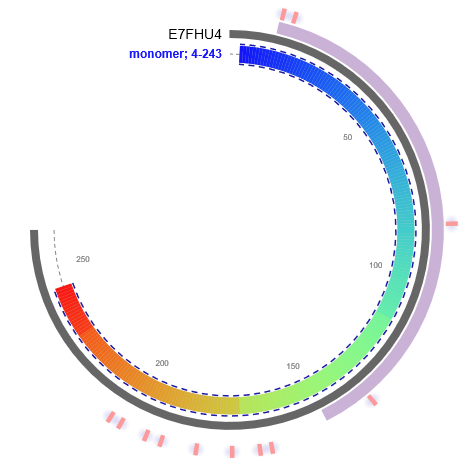Part of a bifunctional enzyme complex that functions as an NADPH-dependent hydrogen-evolving hydrogenase with sulfur reducing activity. May play a role in hydrogen cycling during fermentative growth. Activity not exhibited with NAD. The alpha and delta subunits form the hydrogenase component that catalyzes the reduction of protons to evolve hydrogen. •
MGKVRIGFYALTSCYGCQLQLAMMDELLQLIPNAEIVCWFMIDRDSIEDEKVDIAFIEGS
VSTEEEVELVKKIRENAKIVVAVGACAVQGGVQSWSEKPLEELWKKVYGDAKVKFQPKKA
EPVSKYIKVDYNIYGCPPEKKDFLYALGTFLIGSWPEDIDYPVCLECRLNGHPCILLEKG
EPCLGPVTRAGCNARCPGFGVACIGCRGAIGYDVAWFDSLAKVFKEKGMTKEEIIERMKM
FNGHDERVEKMVEKIFSGGEQ265

| PMID | Title & Author | Abstract | Year | |
| 0 | 2538471 | Characterization of hydrogenase from the hyperthermophilic archaebacterium, Pyrococcus furiosus. Bryant FO, Adams MW. | The archaebacterium, Pyrococcus furiosus, grows optimally at 100 degrees C by a fermentative type metabolism in which H2 and CO2 are the only detectable products. The organism also reduces elemental sulfur (S0) to H2S. Cells grown in the absence of S0 contain a single hydrogenase, located in the cytoplasm, which has been purified 350-fold to apparent homogeneity. The yield of H2 evolution activity from reduced methyl viologen at 80 degrees C was 40%. The hydrogenase has a Mr value of 185,000 +/- 15,000 and is composed of three subunits of Mr 46,000 (alpha), 27,000 (beta), and 24,000 (gamma). The enzyme contains 31 +/- 3 g atoms of iron, 24 +/- 4 g atoms of acid-labile sulfide, and 0.98 +/- 0.05 g atoms of nickel/185,000 g of protein. The H2-reduced hydrogenase exhibits an electron paramagnetic resonance (EPR) signal at 70 K typical of a single [2Fe-2S] cluster, while below 15 K, EPR absorption is observed from extremely fast relaxing iron-sulfur clusters. The oxidized enzyme is EPR silent. The hydrogenase is reversibly inhibited by O2 and is remarkably thermostable. Most of its H2 evolution activity is retained after a 1-h incubation at 100 degrees C. Reduced ferredoxin from P. furiosus also acts as an electron donor to the enzyme, and a 350-fold increase in the rate of H2 evolution is observed between 45 and 90 degrees C. The hydrogenase also catalyzes H2 oxidation with methyl viologen or methylene blue as the electron acceptor. The temperature optimum for both H2 oxidation and H2 evolution is greater than 95 degrees C. Arrhenius plots show two transition points at approximately 60 and approximately 80 degrees C independent of the mode of assay. That occurring at 80 degrees C is associated with a dramatic increase in H2 production activity. The enzyme preferentially catalyzes H2 production at all temperatures examined and appears to represent a new type of "evolution" hydrogenase. | 1989 |
| 1 | 7704275 | Characterization of the locus encoding the [Ni-Fe] sulfhydrogenase from the archaeon Pyrococcus furiosus: evidence for a relationship to bacterial sulfite reductases. Pedroni P, Della Volpe A, Galli G, Mura GM, Pratesi C, Grandi G. | The hydBGDA genes, which encode the four subunits beta, gamma, delta and alpha of the [Ni-Fe] hydrogenase from the archaeon Pyrococcus furiosus, have been isolated and sequenced using a PCR/IPCR-based strategy. From the sequence analysis it appears that the four structural genes are tightly linked and organized in a single transcription unit. The hydD and hydA gene products are related to the small and the large subunits of several archaeal and eubacterial [Ni-Fe] hydrogenases with an overall degree of sequence relatedness ranging from 35% to 50% (identity + similarity). In particular, the amino acid sequence motifs involved in the accommodation of nickel and iron-sulfur clusters are conserved. In addition, the database search revealed that the hydB and hydG gene products are homologous to the asrA- and asrB-encoded subunits of the sulfite reductase enzyme from Salmonella typhimurium. This is particularly interesting in view of the recent finding that the P. furiosus hydrogenase appears to be a bifunctional enzyme endowed with both proton- and sulfur-reducing activities. | 1995 |
Bryant F O , Adams M W W . Characterization of hydrogenase from the hyperthermophilic archaebacterium, Pyrococcus furiosus[J]. Journal of Biological Chemistry, 1989, 264(9):5070-5079. Pedroni P , Volpe A D , Galli G , et al. Characterization of the locus encoding the [Ni-Fe] sulfhydrogenase from the archaeon Pyrococcus furiosus: evidence for a relationship to bacterial sulfite reductases[J]. Microbiology, 1995, 141(2):449-458.